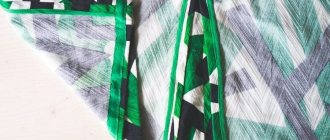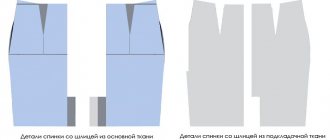Repairing a pocket with your own hands
A pocket is a rather capricious element of clothing. So capricious that most often it is the pockets that need repair. Of course, this is due to their practical use and the need to use them frequently. When the question arises of how to properly sew up a pocket, because small change and other things can fall into the hole in the lining, and the torn outer part of the pocket looks sloppy, you should not immediately run to the studio. You can solve some issues while at home on your own.
To repair a pocket lining you will need even less skill, because the result of your work will be hidden in the depths of the product, so you do not need to bother yourself with perfect, small and even stitches. In addition, most often, when the seam of a patch pocket unravels, visible marks remain, along which it is quite easy and simple to sew a new seam, no less beautiful and neat.
How to sew a pocket - from start to finish, without using special knowledge?
To sew up a pocket yourself, turn the item that needs repair inside the welt pocket inside out. This occurs when the inner seam comes apart. The most common example of this is the front pocket of jeans. Iron the fabric that serves as the base for the part of the pocket that is visible to the eye. After this, you can sew up the pocket either by hand or using a sewing machine with a “back needle” seam. Ideally, the stitches should be small and even. The guideline for your seam should be the mark from the unraveling seam.
The fabric from which the welt pocket parts are made must be pulled out. If there is no way to do this because of the lining, then this situation is not unusual. Remove excess threads and fold the edges of the pocket pieces so that the cut remains inside. After this, sew up the hole with small even stitches, picking up several threads of fabric on the left and right. Fasten the thread and tuck the pocket back.
How to fix a pocket if the fabric is worn out?
If the material from which the welt pocket is made is worn out, it requires replacement. To sew up a pocket, rip out the old pocket, remove the pattern from the piece and transfer it to new fabric. Cut out two pieces in a mirror image. After this, you need to sew the part along the contour, insert it inside the slot for the pocket so that the seams of the product are inside. Small hidden stitches can be used to sew the pocket in place.
How to sew a patch pocket from different sides?
First, you need to iron the item in the place where there is a patch pocket that requires repair. If the stitching has come apart, use threads that match the color to sew up the pocket. You can lay a new line by hand or on a sewing machine, strictly in the place where the original seam was located. You can see it from the needle marks of the previous seam. After this, you need to hide the threads and knots on the wrong side of the pocket.
In any case, no matter what pocket you sew up, this task can most often be safely done at home. Especially if the repair involves the pocket lining and your ability to create beautiful seams will not need to be demonstrated on the front side of the item being repaired.
How to sew up a pocket with a hole in the side?
If a patch pocket that is torn on the side needs repair, then you should also not come up with any special tricks to repair it. Simply stitch by hand or using a sewing machine the entire product and pocket. If the trousers have a lining, then this must be taken into account when repairing the patch pocket and first rip off part of the lining in order to have free access to the area of the torn pocket.
In any case, don’t be afraid to repair things yourself; sewing them up is easier than ever.
Repairing seam damage
The most common problem is seam tearing. Such damage can be caused by a snag in the fabric, a sharp jerk, or poor quality sewing. Dealing with the problem is quite simple. To do this, you will need to take threads of a suitable color and a needle. You also need to know how to properly repair a hole on a down jacket using a machine.
If the garment has a lining, before sewing up a hole in the jacket, you should rip the seam open to make it easier to get to the tear. You need to work as carefully as possible; the stitching should be barely distinguishable from the factory one. To enhance the strength of the new seam, it must be made longer than the size of the hole. You need to start working a few centimeters before the start of the tear and finish 1-2 cm after. To complete the restoration of the jacket, the lining should be sewn back.
How to fix a hole in a jacket at the seam?
The simplest repair method is used if the jacket is torn at the seam. In this case, there is no need to invent anything, since such a hole can be sewn up with thread. Moreover, such a gap can be eliminated even without a sewing machine.
The repair process looks quite simple:
- Choose threads that match the color.
- Turn the product inside out and place it on the table.
- If there is a lining, then spread it out to make it easier to work with the damaged area.
- Thread the needle and carefully sew up the hole. Try to sew so that the new stitch becomes a continuation of the old one, and the seam differs as little as possible from the factory one.
- Sew the lining and turn the product inside out.
If you don't want to rip the lining, sew the jacket with a blind seam. For this:
- Insert a needle from the wrong side of the fabric (so that the knot on the thread is not visible) and sew the hole from the front side with parallel stitches.
- The distances between stitches should be the same.
- After the hole is completely sewn up, fasten the thread and carefully hide it inside.
Important! Braid or reflective tape will help disguise a torn seam on a jacket. You can sew the braid in different ways. Your imagination will help you in the decorating process. Similarly, you can manually sew up the hole under the arm with an invisible seam. Don't be afraid to experiment with color and length:
- A well-chosen braid can not only disguise a torn seam, but also make the jacket stylish and original.
- A reflective tape sewn to the defect site or along the entire width (length) of the jacket will not only look impressive, but will also make the product more visible in the dark.
Or maybe the hole that has appeared is just a reason to give things a new life? We offer you some interesting and fashionable ideas:
How to get rid of a hole in a down jacket
Despite the fact that winter jackets are in most cases made of reinforced materials, they can suffer from various types of damage, from snags to burns. Down jacket repair is carried out using several main methods:
- patches;
- thermal stickers;
- reflective tape;
- decorating the break point using a zipper or fittings.
For convenience, down, fur or synthetic insulation should be fixed or pulled out while the damage is repaired (if such a possibility exists).
The main difficulty when sealing a hole in a down jacket is the inconvenience. If the item is not repaired correctly, the filler may begin to come out. If the task seems difficult, it is recommended to take the jacket to a workshop.
Patch
Iron-on adhesive
Reflective tape
Lightning
Fixing a hole in a down jacket
Many buyers still remember the fashion for bologna outerwear.
It is made of nylon fabric, which includes a special waterproof coating. Nowadays, such products are also popular, because they are famous for their low cost and provide reliable protection in rainy weather.
But such clothes have one drawback - the lack of high strength. It can be easily damaged as a result of chemical or mechanical stress. After which it will be difficult to close the hole.
How to seal a bolognese jacket? In order for the repair to be successful, the first thing you need to do is assess the location of the break.
To eliminate a cut or burn, follow these rules:
- How to seal a bolognese jacket? First, select the correct adhesive composition for repairing the product. Carefully study the label that is on the item, and also test the glue in an inconspicuous area. Glue containing rubber and acetic acid ester has good recommendations. If you don’t have this at hand, try rubber glue or Moment.
- Cut the patch to fit the cut. The best option would be a piece of bologna fabric or rubberized material. The color of the jacket and patch must match.
- Wipe the inside of the product with a cotton pad soaked in acetone. Wait two to three minutes.
- Apply glue to the patch as directed in the instructions. Wait a while.
- Glue a piece of fabric on the wrong side. Place a press in this place that weighs more than one kilogram. Wait one to two hours.
- If the glued tear doesn’t look very neat from the front side, then try decorating the hole with a beautiful applique.
You can seal your jacket in another way:
- You can repair a torn item using two patches. First, trim the ends of the hole using sharp scissors.
- Prepare bologna patches. The inner piece should be slightly larger in size, but the patch on the front side should exactly match in diameter.
- Try to glue both parts together. Rate the appearance. If everything suits you, then place a linen or cotton cloth on top and gently iron it.
How to repair a hole in a jacket if it is burnt?
Seal the damaged area using:
- non-woven tape;
- a piece of fabric of the same color;
- iron;
- gauze.
Tape based on dry glue can be purchased at a special store that sells everything for needlework and sewing.
Once everything is prepared, cut a small piece of the duct tape. It must match the size of the hole. You need to make a small tear on the inside of the down jacket, this will help you easily get to the damaged area.
Place the fabric over the cut and then iron the edges of the hole through the gauze. Sew up the previously made incision. This completes the repair of the product.
How to sew up a pocket or sleeve that has a hole along the seam? At home, mending a cut will not be difficult.
First of all, choose threads that match the color. You can use a machine, but most often such problems are fixed manually.
To make sewing the product more convenient, place it on the table, first turning it inside out. Make sure that the seam is as even as possible.
If the down jacket has a lining, make a small cut in it in the area of damage. At the end of the procedure, sew the lining again.
We invite you to familiarize yourself with 11 mice per night. The best DIY mousetrap
What to do if a defect appears on a leather product? A jacket burned by a cigarette can be repaired using regular Moment glue.
Turn the sleeve inside out and lightly tear off the lining. Straighten the product and cut a small piece of fabric similar in size to the hole. Apply glue to the patch and the defect area. Wait 20 minutes.
After the material has dried, apply glue again. And glue the two parts together. Place the press on top and leave it like that for one to two hours. After the item has dried, check to see if the glued elements are coming off. If everything is fine, then you can close the cut in the lining.
If you have any doubts about how to seal a hole on a Bolognese or leather jacket, then take the product to the nearest studio.
Anyone can tear a thing, be it a child or an adult. To prevent the defect from being visible, you need to know how to properly fix the problem.
Bologna is a synthetic material from which raincoats, down jackets, jackets and sports waterproof clothing are most often sewn. The fabric consists of nylon or nylon, coated with a water-repellent material - silicone or polyacrylate. It is 2 times stronger than cotton fabric.
Bologna is not afraid of water, acids and alkalis. But if you accidentally catch your sleeve on something sharp, a hole will appear on the jacket. Methods for repairing outerwear depend on:
- localization of the defect;
- hole size;
- jacket colors;
- product design.
The most difficult thing to deal with is holes in classic-cut jackets made from light-colored jacket fabric. A hand-darned hole will be visible, and a patch in the shape of an animal or a sports patch will catch the eye. But there is a way out of this situation. Manufacturers of fabrics and accessories produce a variety of finishing materials for clothing that perfectly mask holes in jackets.
If there is a tear along the seam
If a hole appears on the seam, it needs to be sewn up by selecting the desired color of thread. In the absence of a sewing machine, the jacket is repaired manually.
Repair features:
- select a thread that matches the color of the jacket fabric;
- turn the jacket inside out and place it on the table;
- in the area of the hole on the wrong side, rip out the lining;
- Having folded the parts at the tear site, sew the fabric with a stem stitch.
If you don't want to bother with the lining, then sew the jacket with a hidden seam:
- from the inside out, a needle is inserted into the tear site;
- from the front side, two parts of bologna are pulled together with parallel stitches;
- at the end, the thread is taken out from the wrong side and a tack is made so that the seam does not come apart.
Gaps in the area of internal and patch pockets are perfectly masked with decorative braid or trim. The seam will be neat only if the distance between the stitches is the same. To avoid handicraft repairs, you should use a sewing machine.
If desired, the hole in the jacket can be closed with a zipper. If the defect appears on the front of the product on the right, for symmetry, make the same insert on the left. Repair using a zipper will not only get rid of the problem, but will also make the jacket look original.
We suggest you read: How to wash a greasy spot on a jacket, how to remove shiny stains on clothes
DIY jacket repair technique:
- sew up the hole by hand;
- Use tailor's pins to secure the zipper at the top;
- Sew around the perimeter using a machine, choosing a thread of the desired color.
If you don’t have a sewing machine, but you don’t want to bother with hand sewing, then use rivets - rivets.
The simplest models consist of a flat metal cap and a stem-shaped counterpart. If a bolognese jacket has defects in the form of scratches or holes, sewing accessories will help correct the situation. The following are used as patches:
- Braid is a narrow woven or fabric strip that is used for decorative finishing and repair of clothing. It can be used to decorate scratches or cuts, and strengthen seams on the front or back side of the jacket. Differs from decorative tape in increased strength. The braid is made of cotton, linen or wool.
- Appliques are decorative elements made from scraps of fabric, adhesive interlining, decorative buttons, rhinestones, etc. This method of repairing jackets is suitable for creative people who can create entire compositions from pieces of different materials.
- Bias binding is a fabric strip cut on a bias, which is used for edging parts. Suitable for filling holes in the hem area of a sleeve. To prevent the trim from being noticeable, the trim is sewn onto both sleeves at once.
- Chevrons and stripes are decorative elements intended for finishing or repairing clothing. For those who have never held a needle in their hands, adhesive-based fabric patches are suitable. In fabric and accessories sales centers you can purchase original patches in the form of cartoon characters, motivational inscriptions, patriotic symbols, etc.
How to make a patch on a jacket in 5 minutes:
- sew the hole manually with thread of any color;
- attach the adhesive-based patch;
- Place gauze or cotton cloth folded in several layers on top;
- place a heated iron on top for 25-30 seconds.
Under the influence of high temperature, the hot-melt adhesive will become liquid and absorb into the jacket fabric. This patch holds tightly and does not come off even after machine washing.
To cover large defects on the front of the jacket, make a decorative patch pocket. To make the work neat and the decorative insert pleasing to the eye, use a sewing machine.
Making a patch pocket:
- cut out a template from cardboard, taking into account folding allowances (plus 5 mm around the perimeter);
- attach the template to a piece of fabric and trace along the contour with chalk or soap;
- bend 5 mm around the perimeter and iron;
- stitch on a machine, leaving 3 mm from the edge.
Decorating a defect on a Bolognese product with a patch pocket:
- spread the lining over the hole and spread it apart, temporarily securing it with thread;
- attach a pocket on the front side and secure it with tailor's pins;
- Stitch the insert along the very edge using a sewing machine;
- Open the temporary seams on the lining and sew it by hand or by machine.
Having mastered the technique of applying a hidden seam, you will be able to save many items from your wardrobe. To repair the jacket you will need:
- tailor's pins;
- threads to match bologna;
- scissors;
- a needle with a small eye.
How to sew a hole in a jacket with a blind stitch:
- find a hole in the seam;
- fold the two halves of the fabric and pin them together;
- from the front side, pierce both parts with a needle at the border of the bend;
- bring the needle out on the curved part of one of the halves;
- pierce both parts of the jacket fabric with the needle again, departing 1.5 mm from the previous stitch;
- At the end of the seam, bring the needle out from the wrong side and make a tack.
We invite you to familiarize yourself with SanPiN 2.3.2.1324-03 Hygienic requirements for shelf life and storage conditions of food products
Updating outerwear
When something is torn, not everyone can make patches for a jacket with their own hands. But this does not mean that you need to run to the first studio you come across. You can fix the problem using various applications, thermal stickers, braid or tape.
If you have singed a sleeve, pocket or chest area, you can cover the jacket with a beautiful picture. To glue an applique or iron-on sticker, you will need a hot iron.
You can mask the hole located next to the seam with braid. This method is good because it is not necessary to match the part to the color of the down jacket. It is enough to show your imagination.
You can close the cut using reflective tape. The advantage of this method is not only hiding the defect, but also creating good visibility at night.











